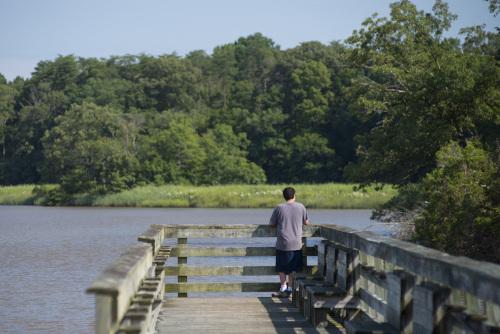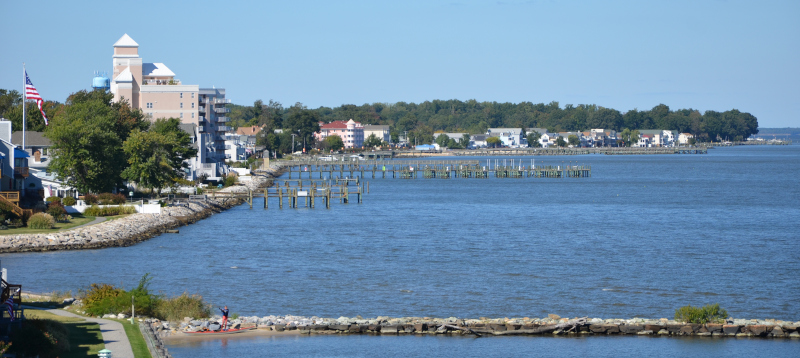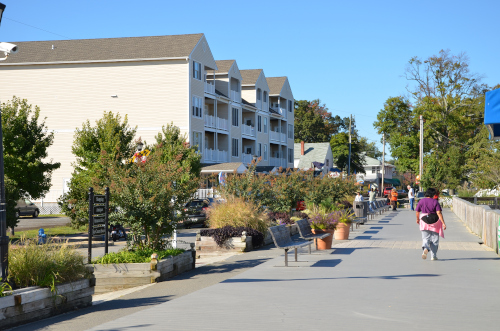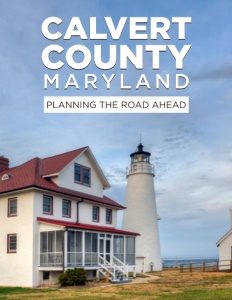Calvert County, Maryland
Planning the road ahead
Business View Magazine interviews representatives of Calvert County, MD, as part of our focus on best practices of local governments.
Established in 1654, Calvert County, Maryland is one of the oldest counties in the United States. The land that eventually became Calvert County was originally inhabited by the Piscataway Indians, who grew corn and tobacco on rich farmlands that were to prove very attractive to colonists arriving from England in the early 1600s. John Smith is reported to be the first European to lay eyes on Calvert County’s peninsula, describing it in his journal as he saw it in 1608, during his exploration of the Chesapeake Bay.

Kings Landing Park
Calvert County, Maryland has a total of 345 square miles, of which 213 square miles is land, and 132 square miles is water. It is bounded by the Chesapeake Bay on the east and the Patuxent River on the west. Steep cliffs and woods predominate on the bay side, while along the Patuxent, rolling fields slip gently down to the river. The county’s many creeks provide refuge for wildlife as well as scenic areas for boating and fishing.
For many years, Calvert County, Maryland was a rural county and its main crop was tobacco. An agricultural community, life there continued without much change into the 20th century. In 1936, the county had only 15.2 miles of paved roads and electrification didn’t come until 1939. However, in the 1980s and ‘90s, the character of the county began to change as road improvements and bridge construction opened it up to new residents who were drawn there from the nearby greater Washington-Arlington-Alexandria Metropolitan area. Today, 92,000 residents live in Calvert County, including in its two incorporated municipalities: North Beach and Chesapeake Beach, and its seven town centers: Solomons, Lusby, St. Leonard, Prince Frederick, Huntingtown, Owings, and Dunkirk.
Navigating these changes, as the county continues to grow, is partly the purview of Mark Willis, a lifelong county resident and current Director of its Planning & Zoning Department. And Willis’ roadmap is the county’s Comprehensive Plan, which according to Maryland State law, must be updated on a regular basis.
“The Comprehensive Plan is the county’s overall, future vision for the next 20 years, and that vision gets updated every five to ten years,” Willis explains. “And it’s never done without the public being involved. It’s a very intense, transparent operation. At the local level, you’re directed by the Planning Commission, because in Maryland, the Planning Commission is a citizen commission; they’re appointed to that Commission by the legislative body, which, in this case, is the Board of County Commissioners. We have between 100 and 150 public interactions, including meetings with the Planning Commission and the Board of County Commissioners, both of whose meetings are public events. We also reach out to the citizenship of this county through town halls, meetings, workshops, and round tables. I’ve spoken to churches, HOAs, the American Legion – we’ve never turned down any group, person, or entity that wants us to talk and to listen to what they have to say.”
“So, the draft Comprehensive Plan is actually owned by the Planning Commission until such time as the members have an updated draft that they feel is adequate, appropriate, and sufficient for maintaining the goals and objectives within the county,” Willis continues. “Then the legislative body, the Board of County Commissioners, will vote on it and either adopt it or not. They can send it back and ask the Planning Commission to tweak things; or the Board can make changes. That’s the process.

North Beach
“Once you have that vision identified for the entire county, of which all of our seven town centers are included, we take a county-wide look at an updated Transportation Plan and look at how we can cause that vision to unfold and develop as we would like it to happen. Once we have that, though, the Comprehensive Plan, without a Zoning Ordinance, is a useless document. You have the vision, but unless you have something to enforce it, it’s for naught. So, we go: Comprehensive Plan, Transportation Plan, followed by a fully updated Zoning Ordinance that helps to make that Transportation Plan and, thereby, that Comprehensive Plan, come alive. The Comprehensive Plan is the vision. It satisfies its purpose when the Zoning Ordinance actually allows for enforcement of it. One has to complement the other; you can’t have a Comprehensive Plan that you’ll never be able to achieve, and you can’t have a Zoning Ordinance that forces things that’s not a vision within the Comprehensive Plan.”
Jenny Plummer-Welker is Calvert County, Maryland’s Long Range Planner. She describes the overall goals of the county’s Comprehensive Plan. “We have four main points,” she avers. “To improve the overall quality of life by promoting sustainable development; to promote a stable and enduring economic base; to provide for safety, health, and education; and to preserve the natural, cultural, and historic assets of Calvert County, Maryland.”
Willis explains that sustainable development is covered in the draft Land Use chapter of the Comprehensive Plan: “The Land Use chapter promotes creating a sustainable land use pattern by creating a balanced mix of residential, recreational, commercial, and industrial uses and is anti-sprawl. Proposed policies allow mixed-uses, and higher development intensities that create more efficient, less consumptive buildings and spaces in the town centers. That’s our goal: to keep what we have, but direct growth where it makes sense. We’re not trying to increase the density of Calvert County, Maryland. What we’re trying to do is just divert it from the rural areas of the county into those receiving areas, which are the town centers and the immediate areas around the town centers. You increase the density within those receiving areas so that a walkable community can occur. When you provide enough density in those areas, you provide for commercial flexibility; businesses then want to move there because they see that the population density will support their businesses. If we can move the population density from our rural areas into our town centers, I think we’ll achieve so many of our goals. We’re big on preservation; but we’re also big on creating a flexible, commercial tax base within the town centers and we’re going to continue in that direction.”
Economic development is largely the responsibility of Kelly Slagle, the Calvert County, Maryland’s Economic Development Director, who says that it’s a constant balancing act between promoting appropriate development while preserving the county’s environmental assets and its rural personality. “We try to focus our economic growth in the town centers and we’re paying close attention to the types of businesses that we’re looking at recruiting into the community, as well as the types of businesses that exist here,” she states. “We know that not every type of industry would be appropriate here in Calvert County, Maryland. We know what we are and we know what we’re not. So, we try to be very cognizant about what types of businesses would work, what types of businesses would be welcomed, and what types of businesses would ultimately be successful. The last thing that we want to do is recruit a business within our community, site them here, and then have them not be successful; because if that’s the case, we truly have not done our job.”

North Beach Boardwalk
According to Slagle, fostering economic resiliency and business growth relies upon a two-pronged approach. “We have a strong business retention program and a business development program,” she notes. “We have a dedicated staff person who works with our existing businesses. First and foremost, her job is to be out with our existing business community, doing everything from site visits, spending one-on-one face time with our business community, asking key questions, seeing how they’re doing, and looking for red flags which are signals for us that something is going on. More often than not, our businesses in Calvert County, Maryland are having good issues and our role is to work with them to make sure that we’re helping them, and bringing resources to bear to allow them to continue to grow.”
“Business development is working often with our existing folks who are going through the expansion process, but it’s also new businesses coming into the county and wanting to locate here,” she adds. “It’s finding out what it is they’re doing; what would be the best location to site them in; and what are their strengths, weaknesses, and assets. We also work with them on the regulatory side as they’re going through the permitting process. Often, there’s a federal level, a state level, and a local level of reviews in order for them to get their final permits so they can be ready for construction. That’s a service that we provide to any and all that are interested in locating here and we have found that to be very successful.”
“The fact is, we want to maintain a rural character, but the objective is to create that unique balance between that and economic development,” says Willis, in conclusion. “You can’t be all residential or all commercial and keep everybody happy, so we’re looking for that balance. Past Comprehensive Plans have done a very good job of moving us in that direction, and this next Comprehensive Plan, and the subsequent policies that will be updated going forward, hope to improve upon those. Times change and you have to keep tweaking it. We’re always looking to see where we are and where we need to go.”
Check out this handpicked feature on Kent County, Maryland – Agricultural by nature.
AT A GLANCE
WHO: Calvert County, Maryland
WHAT: A county of 92,000 residents
WHERE: Between Chesapeake Bay and the Patuxent River
WEBSITE: www.co.cal.md.us
PREFERRED VENDORS

CalvertHealth Medical Center – www.calverthealthmedicine.org
CalvertHealth began in a two-story, frame building in 1919. As the county grew, so did the hospital – upgrading technology, improving facilities and expanding services. From these humble beginnings, it has transformed into a top regional healthcare provider, widely respected as a leader of innovative medicine among community hospitals. Today, the health system includes the medical center, an employed physician network, a diagnostic imaging center, urgent care facilities and more.

College of Southern Maryland – www.csmd.edu
The College of Southern Maryland provides programs at campuses in Calvert, Charles and St. Mary’s counties, with a focus on local workforce development to maintain and grow a healthy economy and community. With tuition and fees about half that of a four-year public university, CSM offers associate degrees, certificate programs and continuing education courses for professional and career development. CSM has guaranteed transfer agreements with more than 60 universities for students to start locally and transfer seamlessly to the college of their choice. Businesses and individuals in need of professional, convenient and reasonably priced training will also find offerings ideal for their training needs. Learn more at www.csmd.edu.



